
Traveling Family Homeschool Update
Since we started traveling full time we haven’t shared much about homeschooling. Before we hit the road we had never homeschooled before and didn’t fancy ourselves much of an expert on the topic. But after being on the road nine months we thought it’s about time to share a homeschool update!
We follow a structured, predetermined curriculum. We have found that we seem to be an anomaly when it comes to full time traveling families and homeschooling. Many full time traveling families believe in “un-schooling” and opt to not follow a strict or predetermined curriculum. While this works for a lot of folks, we weren’t comfortable with this personally. Eventually we will enroll our kids back into “regular” public school and we want them to be in a semi-structured school system while we travel, so they can easily transition back into school when the time comes. Although we don’t necessarily agree with all the standardized testing that happens in our schools – we also wanted our homeschool curriculum to prepare them for this when they re-enroll back in public school. And with all the adjusting we would be doing in moving into the trailer, learning how to tow and care for our home on the wheels and navigating new places, we didn’t want Jeremy to have to do a bunch of planning/prep/creating lessons – so we wanted a curriculum that was pre-planned and vetted first with other families.
 Photo credit: Book Shark
Photo credit: Book Shark
The primarily curriculum we use is Book Shark, a literary-based curriculum, it focuses on the kids reading aloud and listening to others reading aloud. At times we thought we were crazy to buy a curriculum that required 50 pounds of books. Seriously, it’s not the most mobile-friendly curriculum – but we really liked the literary focus and we know reading is one of the most important skills for future success in school. We purchased the complete second grade Book Shark curriculum for Liam (age 8, Second Grade) and the Kindergarten math and writing portions for Hadley (age 5, Kindergarten).
When we started our travels we had two full large bins of books in the back of the truck. As we read the books we give them to other traveling families or donate them to local charities. There are some books that Liam read that we are holding onto for Hadley – but really because space is limited, we cycle through a lot of books. We are down to one bin now thanks to better organizing supplies in the trailer and because we’ve used and gotten rid of some materials.
Book Shark comes with 36 weeks of lesson plans. Each week of curriculum has four (4) days worth of instruction, with the fifth (5) day reserved for art and/or field trips – which works splendidly for our traveling lifestyle! We just completed our 25th full week of official homeschool curriculum. We generally do school four (4) days a week for about 3 hours at a time, with minimal breaks. Jeremy does ALL the homeschooling while Heather usually works. This makes the most sense for our family since Jeremy was a public school teacher for 13 years before we started to travel and Heather needs time daily to work on the road. We purposely choose do school on mornings Saturday thru Tuesday so that we can get out and explore on weekdays – helping us avoid the crowds! We occasionally take weeks off from school for things like DisneyWorld or when we flew home to Washington State for a visit. But we find our kids are happier when we just do a little bit, consistently.
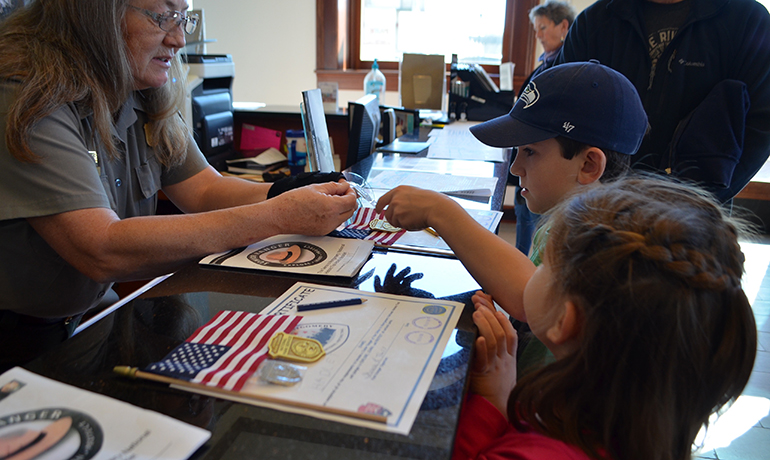
We supplement homeschool with Junior Ranger programs, local library activities, science and history museums, nature hikes and any opportunity we see while traveling. We are all learning so much on the road – everywhere we go seems to provide opportunities for education.
Our kids seem to be thriving educationally. Overall we are really impressed with how much our kids have learned this year. Hadley is reading at a second-grade level and she wasn’t reading at all when we left nine months ago. Liam is reading and doing math at a second- and early third-grade level. School hasn’t always been the easiest for Liam so the one-on-one time with Jeremy has helped tremendously. The kids are journaling about our travels, using computers/technology for doing research about local places we visit, and MOST importantly they are gaining real-world knowledge about people, places and history around the country.
For those of you that are interested in MORE detail about our homeschooling, Jeremy has written up the following details about individual subjects ::
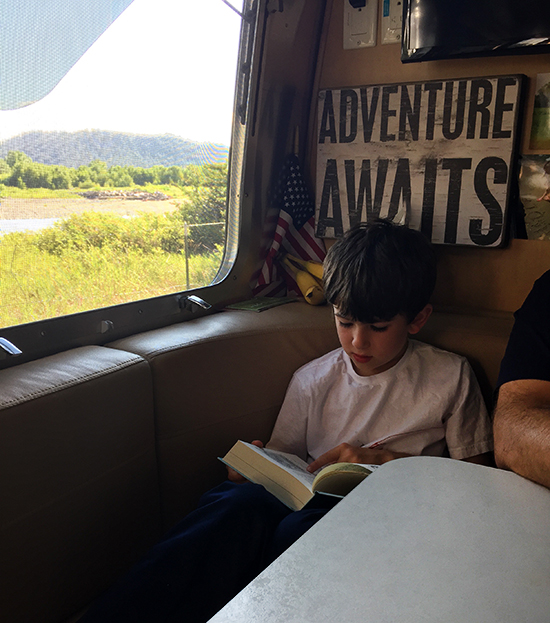
Reading – Every school day Liam reads aloud from a grade level reader. He also listens as I read from a history text (there are three, including a very cool time travel text) and then we discuss. Liam also has a timeline book that he cuts stickers out and places in chronological order as we study history. There are two additional books that I read aloud to both kids, Aesop Fables and a book of poetry. We have almost finished both of these. The kids especially like the Aesop Fables.
I supplement Liam’s reading curriculum with daily reading fluency passages using an iPad app called K12 Timed Reading & Comprehension Practice. This app is wonderful because it tracks progress, gradually gets more difficult and asks three comprehension questions after each passage. Liam also reads Common Core themed passages from two workbooks and answer the corresponding questions – this is important to us because we don’t want district and state tests to be foreign to him when he goes back to public school.
For Hadley, we do NOT use the Bookshark Kindergarten reading curriculum. Instead we’ve used Hooked on Phonics. We had purchased the complete set for Liam many years ago and found it to be a really effective program. Hadley is currently doing second grade Hooked on Phonics exercises. Hadley’s reading also includes reading passages in workbooks with comprehension questions and lots of fiction and nonfiction readers at her reading level. When we first started we did a lot of sight word flashcards, but she is pretty solid in that area and we don’t use the flashcards as much anymore.

Writing/Language Arts – Liam has a set of 8-12 spelling words each week. I make him flashcards to study (good for long road trips), he copies the words and completes other activities throughout the week. He has a spelling test every week. He also does handwriting practice, using the Handwriting without Tears program. The Bookshark language arts program repeats each week. Day 1 is handwriting practice. Day 2 is a grammar lesson with independent practice. Day 3 introduces a type of writing (narrative, creative story, letter, etc…) along with a brainstorming session. Day 4 is when Liam writes a page or so based on his brainstorm from Day 3. I like this language arts program. It allows for a lot of choice in what Liam writes about. I have started to supplement recently with a little extra grammar practice from a workbook for Liam each school day.
Hadley worked through the Kindergarten version of Handwriting without Tears in about three months. I really liked the fact that it included curved and straight wooden blocks she could make the letters with – those were a great visual aid. She now practices handwriting from another workbook that I bought at a homeschool store in New Jersey. She practices grammar (punctuation, capitalization, nouns, verbs and adjectives) daily from a first grade workbook.
Math – Bookshark has the option of choosing from three math curriculums. After researching them, I choose to go with Singapore Math. I have been really pleased with this math program. The program uses the Concrete > Pictorial > Abstract approach to learning. It uses a lot of verbal dialogue between student and teacher as well as a lot of manipulative practice. Each new skill is taught to mastery, it is not a spiral curriculum. Liam just finished learning his multiplication facts from 0-5 and 10, and is currently starting a unit on money. Hadley is working on time, days and the calendar right now. She has worked recently to count the numbers 1 – 30, as well as adding and subtracting the numbers from 1-14. I really like teaching the Singapore Math, as it is challenging for the kids but breaks the math concepts down into small, understandable parts for the kids to learn.
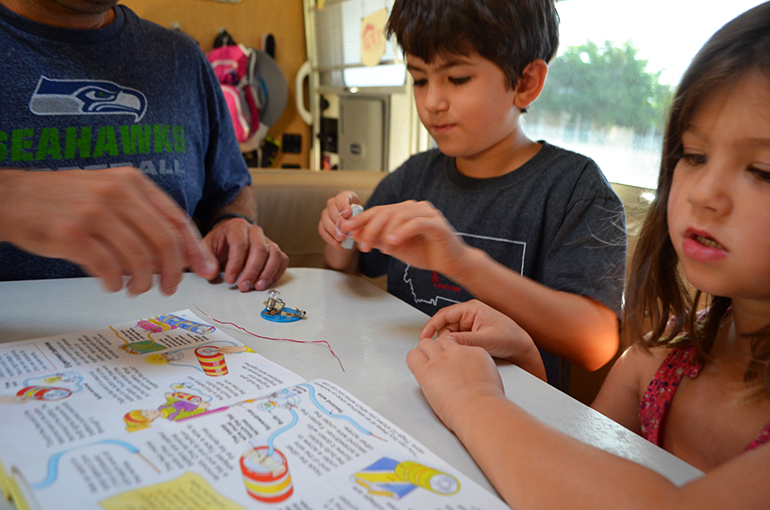
Science – Science consists of two types of lessons: reading a text passage, discussion and answering questions and then conducting science experiments. We have studied animals, the human body, and the weather so far reading the various textbooks. The science experiments that came with the Book Shark curriculum are a big hit. We have experimented with the human voice, reaction times (nervous system), the wind, ice and creating fog and snow, and most recently electrical circuits (pictured above). Plus, thanks to our ASTC membership we have been to science museums all over the country for FREE!
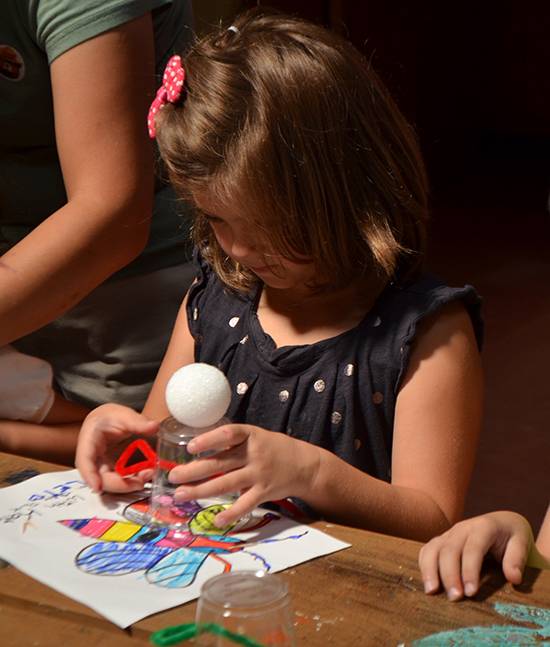
Art – No formal curriculum here. The kids go through stages where they really like art and other times when they aren’t interested. We had each of the kids start a sketch journal early in our travels and about twice a week the kids draw what they remember from the places we’ve visited or things we’ve done. We are hoping this will be a cool keepsake for them to look back at our travels. They also have Play-doh, craft supplies (we find a lot of this on clearance at Target) that they can do during free time, which is often. And when we find programs that work with our schedule, we’ll do FREE art programs through the parks and library systems!
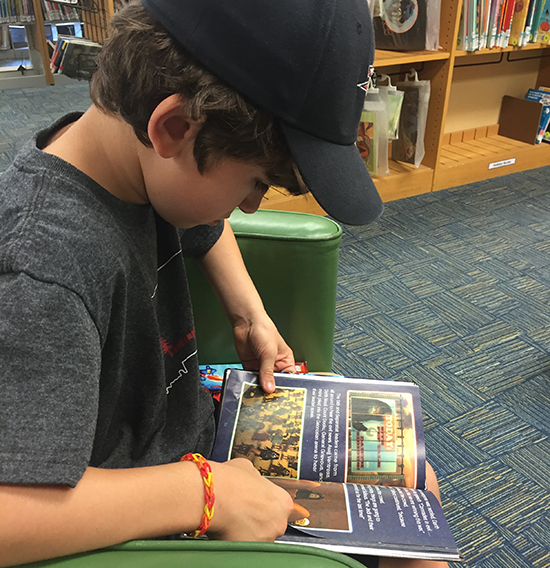
Here is a list of books in our curriculum that we HAVE ALREADY READ, to date. These are the official books in the curriculum that we have read, but we have read many other books, as well. We go to local thrift shops every couple of weeks and pick up reader books at our kids level for $0.50 to $1 each. We turn around and donate them after reading them – much easier than dealing with local libraries since we move so often – it has worked out splendidly along the road.
- Cornstalks: A Bushel of Poems ongoing
- The Aesop for Children – ongoing
- The Door in the Wall
- Strawberry Girl
- Red Sails to Capri
- The Cricket in Times Square
- Tales of Robin Hood
- The School Story
- The Minstrel in the Tower
- Adventures of Sir Lancelot the Great
- Captain Nobody
- Sticks Across the Chimney
- Frog and Toad are Friends
- Frog and Toad Together
- Owl at Home
- Hill of Fire
- Pompeii: Buried Alive!
- Titanic: Lost and Found
- Wagon Wheels
- The Big Balloon Race
- Mouse Tales
- Daniel’s Duck
- Nate the Great
- The Fire Cat
- Greg’s Microscope
- Frog and Toad All Year
- Amelia Bedelia
- Clara and the Bookwagon
- The Long Way to a New Land
- The Long Way Westward
- Prairie School
- The Sword in the Tree currently reading
- Castle Diary
- Eric the Red and Leif the Lucky
- Michelangelo
- Riding the Pony Express
- Good Queen Bess currently reading
We have a lot more books in the curriculum to read, but this is what we’ve read officially in the first 25 weeks of curriculum.
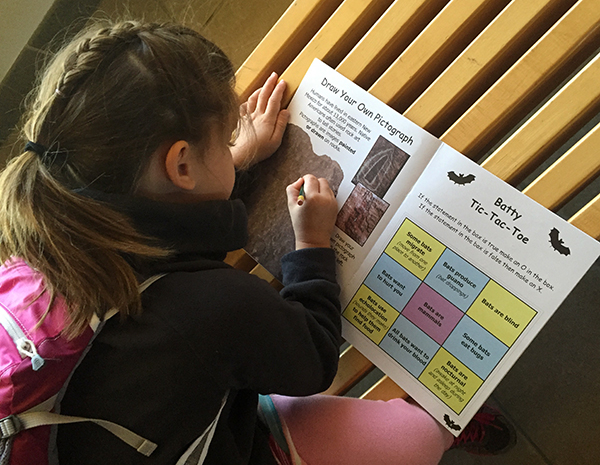
Other learning, not in the formal homeschool curriculum:
- National parks, memorials and historical sites. Kids often complete the Junior Ranger Programs.
- Visiting cultural or scientific landmarks. Niagara Falls, Fenway Park, Notre Dame football Stadium, a Turtle hospital and swimming with dolphins in the Florida Keys, plus so much more

- Visiting science and children’s museums. Thanks to our ASTC membership we get into these museums for FREE nationwide.
- Reading aloud. We have the kids read to us and/or we read to them every evening before bedtime.
- Listening to audiobooks in the car between destinations. We have an Audible membership ($16.95/month) and in the last few months we’ve listened to the complete Chronicles of Narnia series, Ramona Quimbly series, Magic Tree House series and Harry Potter books 1 thru 3. The kids LOVE listening to audiobooks in the car and we love that they don’t have a screen in front of them – so they can see the sights out the window!
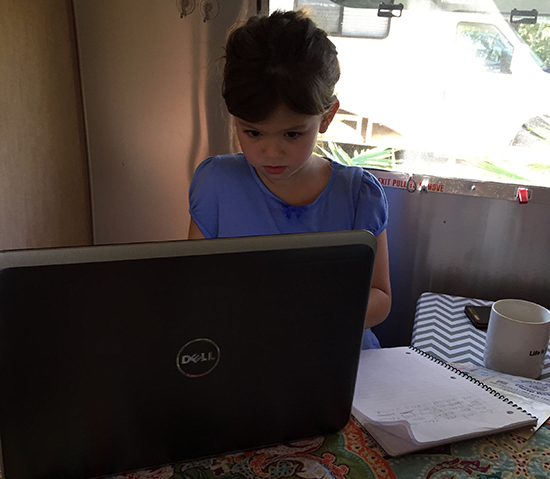
- Using the computer to type up imaginative stories or journaling. Helping the kids familiarize themselves with a keyboard and the computer.
- Workbooks while driving in the car. Costco, the Dollar Store and Goodwill stores have been great for finding workbooks. We keep a clipboard and lots of sharpened pencils in the truck so they can work on workbooks as we drive.
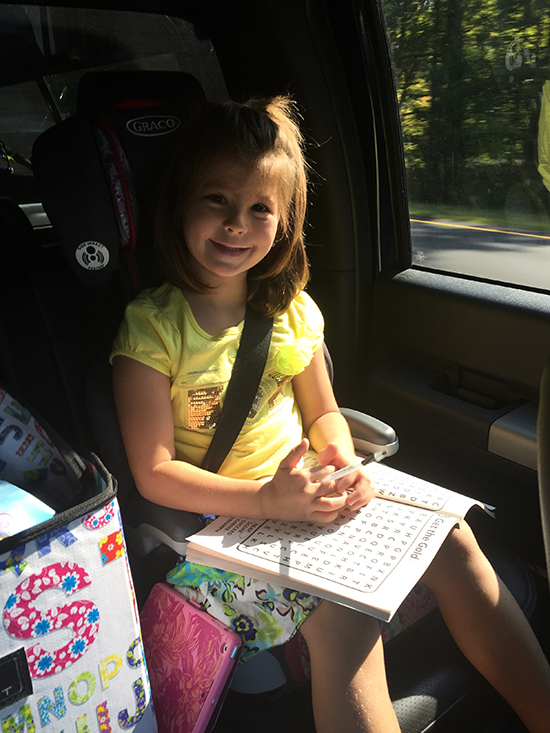
- Activity books while driving in the car. The kids do things like Mad Libs or word search books in the truck during long car rides. We find a lot of activity books (and coloring books) at the Dollar Tree.
- Learning games on the iPad. We will share more about the apps we use in a later post.
- Shopping as a family. We almost always shop for groceries together. The kids actively help us shop and are learning a lot about consumerism and economics. We work as a family to find the best bargains and often don’t buy items that aren’t a good deal.
Some of the supplies we have on hand for homeschooling:
- Dixon Ticonderoga Wood-Cased 2HB Pencils, Pre-Sharpened, Box of 30, Yellow (13830)
- Crayola 24 Ct Colored Pencils, Assorted Colors
- Crayola Classic Color Pack Crayons, Wax, 96 Colors per Box
- Clipboard for each of the kids
- Plain sketch book with comb binding for each of the kids
- Kids scissors
- Apple iPad mini with kid-proof case
So that’s it! Homeschooling is a very personal choice and every family structures their schooling a bit differently. This is how we are doing our best to educate our children (officially) while we travel around the country.
Do you have questions about our homeschool curriculum or doing homeschool on the road? Leave a comment and let us know!


Before we hit the road, we were homeschoolers and I followed a classical education model. But once we hit the road, I became a relaxed roadschooler. I had no idea how much my children would learn about all subjects from our travels. What wonderful memories (and educational opportunities) you are making and giving your children. Makes me want to get back on the road…
I homeschool too. It’s nice to hear how others are making it work for their families. Really enjoy seeing and reading about your travels.
I enjoy reading about homeschooling families. It was nice to hear about the curriculum you are using. I can only imagine how much your children are learning by exploring the country. I like the idea of having them sketch/write about their adventures. Great educational tool AND a fun keepsake.
Thank you so much for sharing. We too have never homeschooled and as much as I dislike all the testing/assessments kids go through in public school it is a fact of life (if you use public schools). I will be researching Book Shark for when we do hit the road. We are also from WA state and I have looked into the K12 online program but would prefer an education that isn’t all computer based. Thank you again for sharing.
How interesting!
We were unschoolers until our children were in 4th grade and 1st grade – we had a family emergency and couldn’t keep homeschooling, so they started mid-year.
After all those years of unschooling, the oldest was a tiny bit “behind” in math, but caught up within a quarter with no assistance.
The youngest hadn’t started reading yet, though he “wrote” pages and pages and could “read” them back to us. It was a linear language similar to English but didn’t have letters we could identify. He had to learn typical language in order to feel successful in a school setting, but again, he was caught up within a quarter. He’s homeschooling again now in 8th grade (a little bit last year, too) but is planning to go to high school next year, then go to Japan as a foreign exchange student in 10th grade, then Running Start (free community college for high schoolers in WA) in 11th and 12th grade. He’ll end up with an AA/AS and high school diploma at 18 🙂
We’ve done a lot of traveling, though we’re not on the road like you guys, and we definitely think that museums and parks and library programs are excellent ways to learn! I enjoyed reading your homeschooling story 🙂
Really appreciate you sharing your journey. I have been mulling over this idea for some time now. The biggest hurdle for me is education for my son. You could easily say we are currently the traditional family. Everyone that I bring this idea up to (full timing), they pretty much think I’m crazy. Though I am not naive of the cons of doing such a thing, I am also well aware of the pros. But back to homeschooling, what “accreditation” do you have to go through so that your kids can walk back into a public school at some point in the future if you chose to do so?